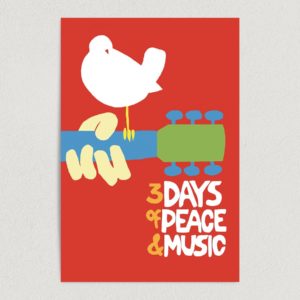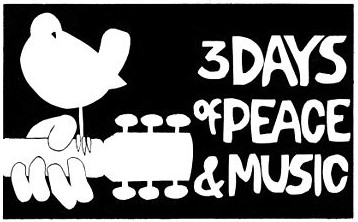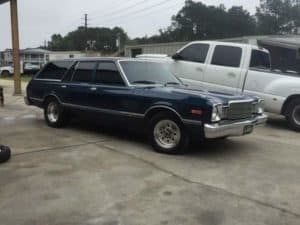 I was a rising high school senior in the summer of 1969. Far away from Bethel, NY, on the coast of California, I never even knew Woodstock was on the horizon. We all read newspapers and magazines and watched the nightly news. So we knew that something momentous happened on a muddy farm 3,000 miles to the east. Something terrifyingly huge, slightly obscene, and wickedly defiant had ignited while I lived my mini-skirted, innocent, bleach-blonded summer among the dry grasses of Northern California.
I was a rising high school senior in the summer of 1969. Far away from Bethel, NY, on the coast of California, I never even knew Woodstock was on the horizon. We all read newspapers and magazines and watched the nightly news. So we knew that something momentous happened on a muddy farm 3,000 miles to the east. Something terrifyingly huge, slightly obscene, and wickedly defiant had ignited while I lived my mini-skirted, innocent, bleach-blonded summer among the dry grasses of Northern California.
Woodstock, like most unexpected events, might not have occurred, had the stars not aligned. Two young guys, 24-year old Michael Lang, and 26-year old Artie Kornfeld had an idea for a Studio-in-the-Woods north of New York City. Kornfeld was already a vice-president at Capitol Records, but he and Lang needed financial backing. Enter two other young guys in their mid-twenties, entrepreneurs Joel Rosenman and John Roberts. Roberts was an heir to the Polident/Poli-grip fortune, and Rosenman was Robert’s good friend with a musical background. They had met on a golf course and were apartment mates in New York City. The two described themselves as “young men with unlimited capital.”
Within months, Woodstock morphed from a plan to build a studio that would attract big-named bands and musicians to an idea for an outdoor concert initially planned for just a few thousand. That audience of a few thousand grew, well-known bands, signed on, and larger and larger sites were sought. Simply, what followed at Yasgur’s farm would not have happened without these four young men, hundreds of performers, the generosity of Max and Mimi Yasgur and neighboring townsfolk, free-flowing dollars of John Roberts and his family, the 400,000 to 500,000 concert-goers, the rolling hills of Bethel, New York, and the adequate preparation. And helicopters. Dozens of them.
“The New York Thruway is closed, man,” Arlo Guthrie, exclaimed.
The NY Thruway wasn’t actually closed. But it very nearly was, and the smaller routes leading into the countryside were indeed jammed. Concert-goers abandoned their cars miles from the event. Musicians had to be fetched and returned by privately-contracted helicopters paid for by the producers. So many people got to Yasgur’s farm, sometimes days earlier than the event was to begin, that no tickets were actually sold on site. Everyone, with or without the advance tickets, was let in. (The tickets for the three-day event were $18 in advance and would have been $24 at the gate.)
1969 was, to use a cliché, a watershed year. The Beatles had happened and were happening still, and the music was changing monthly. The Vietnam War was raging on. Drugs, love, and freedom were marching across the country from every direction, particularly from the west coast. Revolution on campuses, in fashion, on television, and in music stormed like a tidal wave across the country, reaching every city and small town in America. Woodstock was both a catalyst and a result of an era that amazed everyone.
In Rockin’ the Free World! How the Rock & Roll Revolution Changed America and the World, Sean Kay writes that rock and roll was “an idea, an attitude, and a way of thinking about the world.” The rock and roll that exploded in New York state at Woodstock, with hundreds of thousands of participants, and then millions more who witnessed the film and soundtrack, changed history for all of us.
Woodstock was released six months later in March 1970 (the documentary film authorized by the producers, now in debt after the costs the event far exceeded any profit). Fifty years ago was certainly a different era. No smartphone cameras or audio recorders, no YouTube, Instagram, Twitter, or the Internet. Yet, the three-hour film allowed everyone to experience Woodstock. Performances were included by some already-famous artists and bands (Jimi Hendrix, The Who, Janis Joplin), and some were made famous by their appearance (Crosby, Stills & Nash, Richie Havens, Santana). The film won the Academy Award for Best Documentary Feature in 1970, although it hardly needed the award to be successful. The non-simultaneously-released soundtrack hit the record stores on May 11, 1970, in time for my 18th birthday, graduation from high school and a summer of musical bliss. Demonstrations against the Vietnam War ramped up when a generation who witnessed Woodstock vicariously sang along to Country Joe’s Vietnam song. It was unfortunate, but soldiers fighting in that war came home to a generation made even angrier by Jimi Hendrix’s Star-Spangled Banner and its striking and haunting guitar chords mimicking the sounds of battle. Yet, it is arguably those songs that helped the Vietnam War end in 1974.
A half-century after Woodstock, the songs and scenes are part of at least one or two generations’ psyche. A majority of parents, World War II vets, and Republicans were repulsed. Yet, Max Yasgur, the Republican dairy farmer who allowed the event on his land, supported the war. However, he believed in freedom of speech and was repulsed by the discrimination others in the geographic area felt towards the younger people attracted to Woodstock.
The fiftieth anniversary of Woodstock was never pulled off this past summer. It was canceled by the event coordinators. Only three of those four young men are alive today. Yasgur moved to Florida and died four years after the event.
In Never a Dull Moment: 1971 The Year That Rock Exploded (2016), David Hepworth wrote that Woodstock the film “was a greater watershed than Woodstock the event. For the people who actually endured three days in the mud and chaos… the festival was a standard mixed bag. The people whose heads were really turned were the millions who had the experience mediated through” the film. The Woodstock Generation grew dramatically with the film and soundtrack.
You can relive Woodstock, or experience it for the first time, by watching the documentaries available on DVD at the library: the original three-hour Woodstock: 3 Days of Peace and Music or PBS American Experience documentary, Woodstock: Three Days that Defined a Generation. Two pictorial works, Woodstock 1969: The Lasting Impact of the Counterculture (2018) and Woodstock: Three Days that Rocked the World (2019) are full of wonderfully nostalgic photos, quotes, and memories.
If you were a teen or young adult in 1969 or the years following, if you were at Woodstock, or you experienced it vicariously through the albums and documentary in 1970, the words of Joni Mitchell (who never was at Woodstock but was the girlfriend of Graham Nash) will resonate with you. I know they do with me.
“By the time we got to Woodstock, we were half a million strong. And everywhere there was song and celebration. And I dreamed I saw the bombers riding shotgun in the sky. And they were turning into butterflies above our nation. We are stardust billion-year-old carbon. We are golden, caught in the devil’s bargain. And we’ve got to get ourselves back to the garden.”
Charlotte Canelli is the Director of the Morrill Memorial Library in Norwood, MA. Look for her article in the September 12, 2019 issue of the Transcript and Bulletin.




